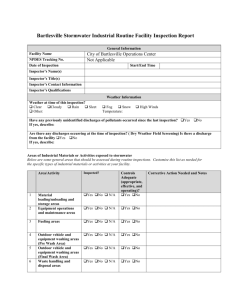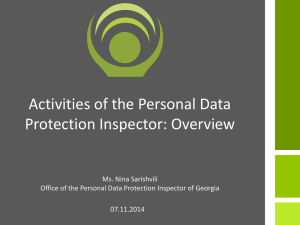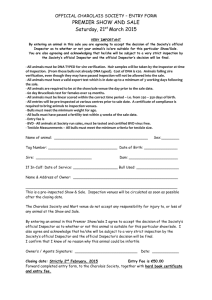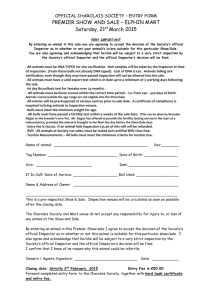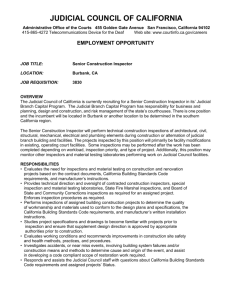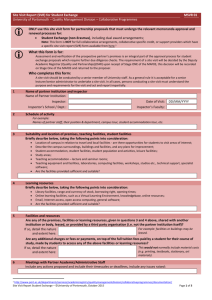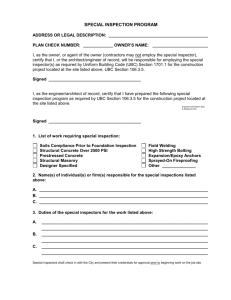Title 9 - Maryland Department of Labor, Licensing and Regulation
advertisement
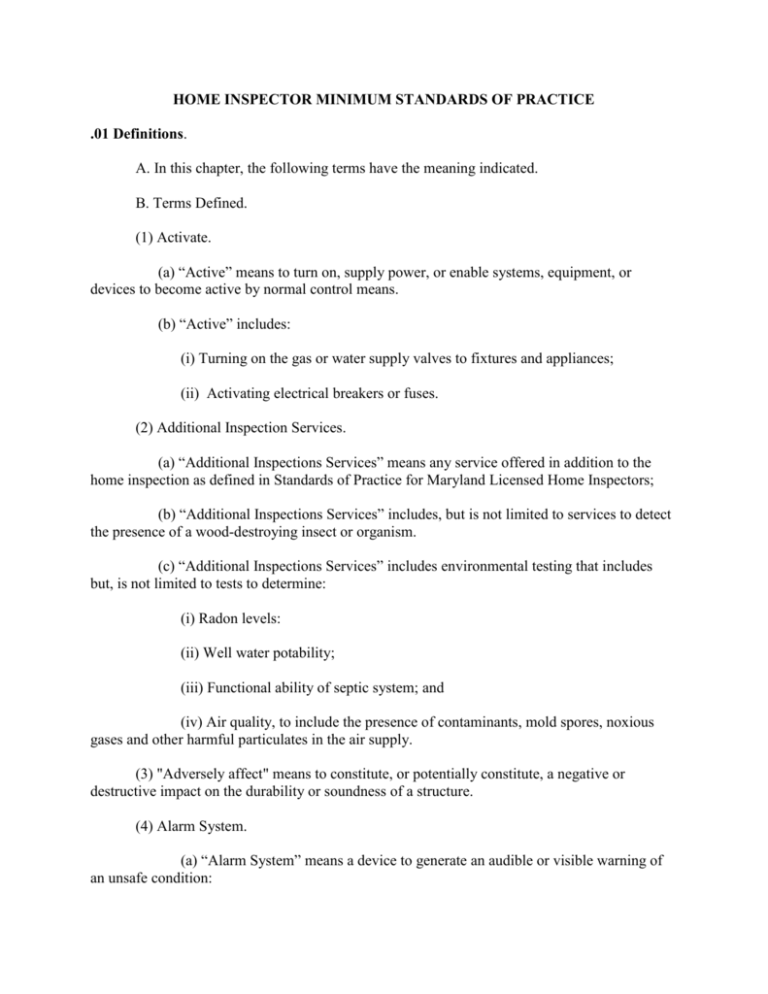
HOME INSPECTOR MINIMUM STANDARDS OF PRACTICE .01 Definitions. A. In this chapter, the following terms have the meaning indicated. B. Terms Defined. (1) Activate. (a) “Active” means to turn on, supply power, or enable systems, equipment, or devices to become active by normal control means. (b) “Active” includes: (i) Turning on the gas or water supply valves to fixtures and appliances; (ii) Activating electrical breakers or fuses. (2) Additional Inspection Services. (a) “Additional Inspections Services” means any service offered in addition to the home inspection as defined in Standards of Practice for Maryland Licensed Home Inspectors; (b) “Additional Inspections Services” includes, but is not limited to services to detect the presence of a wood-destroying insect or organism. (c) “Additional Inspections Services” includes environmental testing that includes but, is not limited to tests to determine: (i) Radon levels: (ii) Well water potability; (iii) Functional ability of septic system; and (iv) Air quality, to include the presence of contaminants, mold spores, noxious gases and other harmful particulates in the air supply. (3) "Adversely affect" means to constitute, or potentially constitute, a negative or destructive impact on the durability or soundness of a structure. (4) Alarm System. (a) “Alarm System” means a device to generate an audible or visible warning of an unsafe condition: (b) “Alarm system” includes, but is not limited to: (i) A warning device installed or free-standing; (ii) A carbon monoxide detector and alarm; (iii) A flue gas detector; (iv) A water or other spillage detector; (v) Security equipment; (vi) An ejector pump; and (vii) A smoke detector or alarm. (5) "Automatic safety controls" means a device designed and installed to protect systems and components from unsafe conditions. (6) “Component" means a permanently installed appliance, fixture, element or part of a system necessary for the system to operate as designed. (7) "Decorative" means ornamental or something not required for the operation of the essential systems and components of a home. (8) "Describe" means to report a system or component by its type or other observed. significant characteristics to distinguish it from other systems or components. (9) "Dismantle" means to take apart or remove any component, device or piece of equipment that would not be taken apart or removed by a homeowner in the course of normal and routine homeowner maintenance. (10) “Engineering service" means a professional service or creative work requiring (a) Engineering education, training, and experience; and (b) The application of special knowledge of the mathematical, physical and engineering sciences to such professional service or creative work as consultation, investigation, evaluation, planning, design and supervision of construction for the purpose of assuring compliance with the specifications and design, in conjunction with structures, buildings, machines, equipment, works or processes. (11) "Functional drainage" means a drain is: (a) Able to empty in a reasonable amount of time; and 2 (b) Not subject to overflow when one of its supply faucets is left on. (12) “Functional flow” means sufficient water flow to provide uninterrupted supply to the highest, unrestricted tap or faucet farthest from the source when a single intermediate, unrestricted tap or faucet is operated simultaneously with uninterrupted flow. (13) “Further evaluation” means an examination and analysis by a qualified professional, tradesman, or service technician beyond that provided by the home inspection. (4) Heat source. (a) “Heat source” means a mechanical means to transfer heat; (b) “Heat Source” includes but is not limited to: (i) A radiator; (ii) A convector unit; (iii) A radiant panel; (iv) A heat pipe; (v) Ductwork; (vi) A grille; (vii) A register; and (viii) Any other device from which heat is intended to be emitted. (15) "Household appliance" means a kitchen or laundry apparatus designed to perform a particular task or function, whether installed or free-standing. (16) "Inspect" means to examine readily accessible systems and components of a building in accordance with these Standards of Practice, using normal operating controls and opening, readily openable access panels. (17) "Installed" means attached such that removal requires tools. (18) "Intended function" means: (a) Performing, or able to perform the usual function for which an item is Designed, or fitted; and (b) Being in a condition or state of repair appropriate to this function, its age and 3 location. (19) "Normal operating control" means a device such as a thermostat, switch, or valve that may be operated by an individual and does not require specialized skill or knowledge. (20) “Readily accessible" means available for visual inspection without requiring moving of personal property, dismantling, destructive measures, or any action which will likely involve risk to a person or property. (21) "Readily openable access panel" means a panel provided for homeowner inspection and maintenance that is within normal reach, can be easily removed by one person, and is not sealed in place. (22) Recreational facility. (a) “Recreational facility” means a fitness or entertainment device or equipment: (b) “Recreational facility” includes, but is not limited to: (i) A spa; (ii) A sauna; (ii) A steam bath; (iv) Exercise equipment; (v) Entertainment devices; (vi) Athletic equipment; (vii) Playground equipment; and (viii) Other similar equipment and associated accessories. (23) "Representative number" means a quantity of components of any system or structure enough like others in its class or kind so as to serve as an example of the class or kind. (24) "Roof drainage system" means a component used to carry water off a roof and away from a building. (25) "Shut down" means a state in which a system or component cannot be operated by normal operating controls. (26) "Significantly deficient" means to be unsafe or not functioning as deigned or intended. 4 (27) Solid fuel burning appliance. (a) “Solid fuel burning appliance” means a hearth and fire chamber or similar prepared place: (i) In which a fire may be built; and (ii) That is constructed in conjunction with a chimney; (b) “Solid fuel burning appliance” includes a listed assembly of a fire chamber, its chimney and related factory-made parts designed for unit assembly without requiring field construction. (28) "Structural component" means a component that supports nonvariable forces or weights and variable forces or weights. (29) “Systems” means a combination of interacting or interdependent components that are designed and assembled to carry out one or more functions. (30) "Technically exhaustive" means an investigation that involves dismantling, the extensive use of advanced techniques, measurements, instruments, testing, calculations, or other means to identify concealed conditions or latent defects. (31) “Under-floor crawl space” means the area within the confines of the foundation and between the ground and the underside of the floor. (32) “Unsafe” means a condition in a readily accessible, installed system or component which is deemed to create a significant risk of personal injury during normal, day-to-day use, which may be the result of damage, deterioration, improper installation or a change in accepted residential construction standards. (33) Wiring methods. (a) “Wiring methods” means the identification of electrical conductors or wires by their general type. (b) “Wiring methods” includes. but is not limited to: (i) Non-metallic sheathed cable; (ii) Armored cable; and (iii) Knob and tube. .02. General. 5 A. Purpose. In the general public interest, these standards are promulgated to establish a minimum and uniform standard of performance to be exercised by a home inspector licensed by the Maryland State Commission of Real Estate Appraisers and Home Inspectors. B. Conflicts. If these regulations conflict with other Federal or State requirements, the home inspector shall follow the more stringent requirements. C. Scope. The Standards of Practice apply only to the inspection of residential building containing one to four dwelling units. D. Inspections. (1) These standards of practice set forth in this chapter: (a) Identify the items, components, systems and certain terms included in the scope of a home inspection; and (b) Apply to a visual inspection of the readily accessible areas of the included items, components, and systems are performing their intended function or are determined to be significantly deficient. (2) A home inspection performed in accordance with the standards of practice set froth in this chapter: (a) Is intended to provide a client with objective information regarding the condition of the systems and components of a home as inspected at the time of the home inspection; (b) Acts to identify visible defects and conditions that, in the judgment of the home inspector, adversely affect the function or integrity of the items, components, and systems inspected, including those items or components near the end of their serviceable life; (c) May not be construed as a compliance inspection pursuant to any code or governmental regulation; (d) Is not an express or implied warranty or a guarantee of the adequacy, performance or useful life of any item, component, or system in, on, or about the inspected property; (e) Is based on the visual observation of the home inspector; and (f) Shall be performed in a time period sufficient to allow compliance with the provisions of the standards of practice set forth in this chapter. E. Representative Number. For the purpose of making a finding or conclusion as a result of a home inspection, an inspector may consider for representative number: 6 (1) Electrical outlets; (2) Exterior windows; (3) Exterior shutters; (4) Doors; and (5) Siding materials. F. Report. A home inspection report: (1) Shall contain the written opinions of the home inspector based upon the judgment and experience of the home inspector; (2) Is not intended to be technically exhaustive; and (3) May identify items in need of further evaluation. .03 Limitations and Exclusions. A. A home inspection performed in accordance with these Standards of Practice: (1) Is not technically exhaustive; and (2) May not identify concealed conditions or latent defects. B. Except as may be required by lawful authority, a home inspector is not required to perform any action or make any determination unless specifically stated in these standards of practice set forth in this chapter. C. A home inspector is not required to determine any of the following: (1) Condition of a system or component which is not readily accessible; (2) Remaining life of any system or component; (3) Strength, adequacy, effectiveness, or efficiency of any system or component; (4) Causes of any condition or deficiency; (5) Methods, materials, or costs of corrections; (6) Future conditions including, but not limited to, failure of systems and components; 7 (7) Suitability of the property for any specialized use; (8) Property boundary lines or encroachments; (9) Compliance of the structure with applicable provisions of local ordinances, regulations, or codes; (10) Market value of the property or its marketability; (11) Advisability of the purchase of the property; (12) Indoor air quality or sickness of any building including, but not limited to, the presence or absence of all manner of biological activity, such as carcinogens, mold, insects, birds, pets mammals, and other flora and fauna, and their consequent damage, toxicity, odors, waste products, and noxiousness; (13) Effectiveness of any system installed or methods utilized to control or remove suspected hazardous substances; (14) Operating costs of a system or component; (15) Acoustical properties of any system or component; or (16) The existence of manufacturer's recalls. D. A home inspector is not required to offer or perform: (1) Any act or service contrary to law; (2) Engineering services; (3) Work in any trade or any professional service other than home inspection; or (4) Warranties or guarantees of any kind. E. A home inspector is not required to operate any system or component that: (1) Is shut down or otherwise inoperable; or (2) Does not respond to normal operating controls. F. A home inspector is not required to enter: (1) Any area that may be, in the opinion of the home inspector, dangerous to the inspector or other persons or damage the property or its systems or components; or 8 (2) Under-floor crawl spaces or attics those are not readily accessible. G. A home inspector is not required to inspect any of the following: (1) Underground items including, but not limited to, underground storage tanks or other underground indications of their presence, whether abandoned or active; (2) Systems or components which are not installed; (3) Decorative items; (4) Systems or components located in areas that are not entered in accordance with these standards of practice set forth in this chapter; (5) Detached structures other than garages and carports; (6) Common elements or common areas in multi-unit housing, such as condominium properties or cooperative house; or (7) A common condominium component, system, or evaluated condominium reserve accounts. H. A home inspector is not required to: (1) Perform any procedure or operation which may, in the opinion of the inspector, be dangerous to the inspector or other persons or damage the property or its systems or components; (2) Move suspended ceiling tiles, personal property, furniture, equipment, plants, soil, snow, ice, or debris; (3) Dismantle any system or component, except as explicitly required by these standards of practice set forth in this chapter; or (4) Include in a written report any information from any source concerning previous: (a) Property, geological, environment or hazardous waste conditions; (b) Manufacturer recalls or conformance of proper manufacturers’ installation of any component or system, or information contained in a consumer protection bulletin of publication. .04 Structural System. A. The home inspector shall visually inspect the structural system, including the structural components including foundation and framing. 9 B. Probing. (1) A home inspector may probe a representative number of structural components where deterioration is suspected or where clear indications of possible deterioration exist. (2) Probing is not required: (a) If it will damage any finished surface; or (b) Where no deterioration is visible. C. A home inspector shall describe the structural system, including the: (1) Foundation, and report the methods used to inspect the under-floor crawl spaces and basements; (2) Floor structure; (3) Wall structure; (4) Ceiling structure; and (5) Roof structure and report the methods used to inspect the attic. D. A home inspector is not required to: (1) Provide any engineering service; or (2) Offer an opinion as to the adequacy of any structural system or component. 05 Exterior. A. A home inspector shall visually insect the home exterior including: (1) Exterior wall covering, flashing and trim; (2) All exterior doors; (3) Attached decks. balconies, stoops, steps, porches, and their associated railings; (4) Eaves, soffits, and fascias where accessible from the ground level; (5) Vegetation, grading, surface drainage and retaining walls on the property when any of these may adversely affect the building; and 10 (6) Walkways, patios, and driveways leading to dwelling entrances. B. A home inspector shall describe the exterior wall covering. C. A home inspector is not required to inspect any of the following: (1) Screening, shutters, awnings, and similar seasonal accessories: (2) Fences; (3) Geological, geotechnical or hydrological conditions; (4) Recreational facilities; (5) Outbuildings; (6) Seawalls, break-walls, and docks; or (7) Erosion control and earth stabilization measures. .06 Roof System. A. A home inspector shall visually inspect a roof system including: (1) The roof covering; (2) Roof drainage systems; (3) Flashings; and (4) Skylights, chimneys, exterior and roof penetrations. B. A home inspector shall describe the roof covering and report the methods used to inspect the roof. C. A home inspector is not required to: (1) Inspect: (a) Antennae; (b) Interiors of flues or chimneys which are not readily accessible; or (c) Other installed accessories. (2) Walk on or access a roof where it could damage the roof or roofing material or be 11 unsafe for the home inspector; (3) Remove snow, ice, debris. or other conditions that prohibit the observation of the roof surfaces; or (4) Determine remaining life expectancy of roof coverings, the presence or absence of hail damage; manufacturers’ defects, exceptions, installation methods, or number of layers of roofing material. .07 Plumbing System. A. A home inspector shall visually inspect the plumbing system including: (1) Interior water supply and distribution systems including all fixtures and faucets; (2) Drain, waste and vent systems including all fixtures; (3) Water heating equipment; (4) Vent systems, flues, and chimneys; (5) Fuel storage and fuel distribution systems; (6) Drainage sumps, sump pumps, and related piping; (7) The functional flow of all fixtures and faucets, and (8) The functional drainage of all fixtures. B. A home inspector shall describe the plumbing system including: (1) Water supply, drain, waste, and vent piping materials: (2) Water heating equipment including the energy source; and (3) The location of main water and main fuel shut-off valves; and (4) The presence of CSST with the recommendation that the bonding of the CSST be reviewed by a licensed master electrician. C. A home inspector is not required to: (1) Inspect any of the following: (a) Clothes washing machine connections; 12 (b) Interiors of flues or chimneys which are not readily accessible; (c) Wells, well pumps, or water storage related equipment; (d) Water conditioning systems; (e) Solar water heating systems; (f) Fire and lawn sprinkler systems; or (g) Private waste disposal systems. (2) Determine: (a) Whether water supply and waste disposal systems are public or private; (b) The quantity or quality of the water supply; or (c) Operate safety valves or shut-off valves. .08 Electrical Systems. A. A home inspector shall visually inspect an electrical system including: (1) The service drop; (2) Service entrance conductors, cables, and raceways; (3) Service equipment and main disconnects; (4) Service grounding; (5) Interior components of service panels and sub panels; (6) Conductors; (7) Overcurrent protection devices; (8) A representative number of installed lighting fixtures, switches, and receptacles; (9) Ground fault and arc fault circuit interrupters; and (10) The general condition of visible branch circuit conductors that may constitute a hazard to the occupant or the structure by reason of improper use or installation of electrical components. 13 B. A home inspector shall describe the electrical system, including the: (1) Amperage and voltage rating of the service; (2) Location of main disconnect and sub panels; and (3) Wiring methods. C. A home inspector shall include in a written report the: (1) Presence of solid conductor aluminum branch circuit wiring; and (2) Absence of smoke detectors. D. A home inspector is not required to: (1) Inspect: (a) Remote control devices unless the device is the only control device; (b) Alarm systems and components; (c) Low voltage wiring. systems and components; or (d) Ancillary wiring, systems and components that are not a part of the primary electrical power distribution system; or (2) Measure amperage, voltage, or impedance. .09 Heating System. A A home inspector shall visually insect: (1) Installed heating equipment; (2) Vent systems, flues, and chimneys; and (3) Heating distribution. B. A home inspector shall describe energy sources and heating methods by distinguishing characteristics and means of distribution. C. A home inspector is not required to: (1) Inspect: 14 (a) Flue or chimney interiors that are not readily accessible; (b) Heat exchangers; (c) Humidifiers or dehumidifiers; (d) Electronic air filters; or (e) Solar space heating systems; (2) Determine the adequacy of the heat system or the distribution balance. .10 Air-Conditioning System. A. A home inspector shall inspect the installed central and through-wall cooling equipment. B. A home inspector shall describe energy sources and cooling methods by distinguishing characteristics and means of distribution. C. A home inspector is not required to: (1) Insect electronic air filters; or (2) Determine the adequacy of the cooling system or the distribution balance. .11 Interior. A. A home inspector shall visually insect: (1) Walls, ceilings, and floors; (2) Steps stairways, and railings; (3) Countertops and a representative number of installed cabinets; (4) A representative number of doors and windows; and (5) Garage doors and garage door operators. B. A home inspector is not required to inspect: (1) Paint, wallpaper, and other finish treatments; (2) Carpeting; 15 (3) Window treatments; (4) Central vacuum systems; (5) Household appliances; or (6) Recreational facilities. .12 Insulation and Ventilation. A. A home inspector shall visually inspect: (1) Insulation and vapor retarders in unfinished spaces; (2) Ventilation of attics and foundation areas; and (3) Mechanical ventilation systems. B. A home inspector shall describe: (1) Insulation and vapor retarders in unfinished spaces; and (2) If applicable, the absence of insulation in unfinished spaces at conditioned surfaces. C. A home inspector is not required to: (1) Disturb insulation or vapor retarders; or (2) Determine indoor air quality. .13 Fireplaces and Solid Fuel Burning Appliances. A. A home inspector shall visually inspect: (1) System components of fireplaces and solid fuel burning appliances; and (2) Vent systems, flues, and chimneys. B. A home inspector shall describe: (1) Fireplaces and solid fuel burning appliances; and (2) Chimneys. C. A home inspector is not required to: 16 (1) Inspect: (a) Interiors of flues or chimneys: (b) Firescreens and doors; (c) Seals and gaskets; (d) Automatic fuel feed devices; (e) Mantles and fireplace surrounds; (f) Combustion make-up air devices; or (g) Gravity controlled and fan assisted heat distribution assists; (2) Ignite or extinguish fires; (3) Determine draft characteristics; or (4) Move fireplace inserts or stoves or firebox contents. 17

